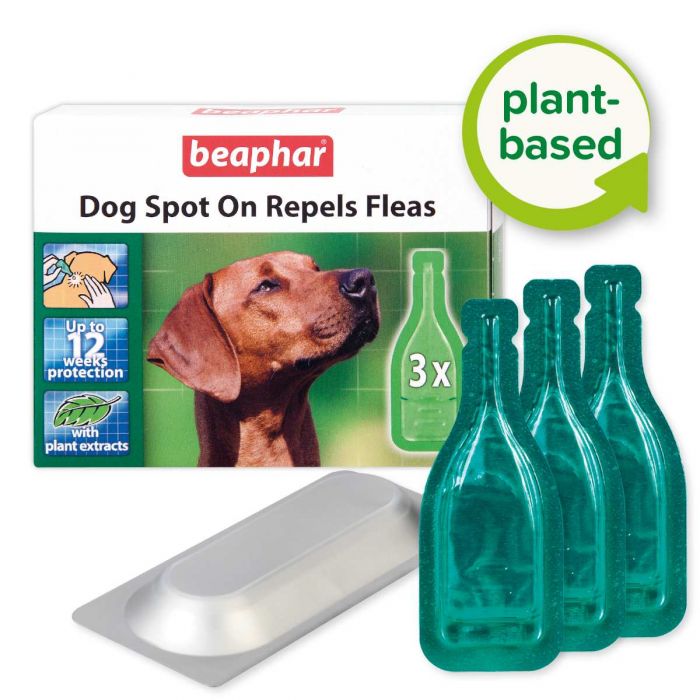
As every responsible pet owner knows, regular flea treatment is essential to keeping these pesky parasites at bay. There are so many flea treatments available, but what are the differences and how do we choose between them? Why are some flea treatments available over the counter, yet others require a prescription? In this blog, we’ll answer some of the most frequently asked questions about active ingredients in flea treatments and explain how they work to protect your pet.
Flea Treatment Ingredients
The active ingredients in a flea treatment are the substances that have an effect on the body of the pet, or directly on the parasite. Different flea treatments will contain different active ingredients – some may only have one, while others might contain a combination.
Fipronil, imidacloprid and s-methoprene are all common active ingredients used in spot-on flea treatments.
What is Fipronil?
Fipronil is a long-established, broad-spectrum insecticide. It’s the main ingredient used in many spot-on treatments, which are applied as a liquid to the back of your pet’s neck.
When applied as a spot-on flea treatment, fipronil spreads across the whole body of your cat or dog via body oils. This takes about a day, and fipronil then releases over time, usually for about a month.
This makes fipronil ideal for use as a preventative measure as well as an effective treatment to get rid of fleas. It kills fleas by attacking their nervous system upon contact, causing hyperactivity and then death.
Fipronil-only products include: Frontline Spot On for Dogs and Cats, Fiprotec for Dogs and Cats, Flevox, Fiproclear, and Effipro for Dogs and Cats.

What is Imidacloprid?
Also frequently used in spot-on treatments, imidacloprid is a very fast-acting insecticide. It’s an alternative active ingredient to fipronil, and works by disrupting the flea’s nervous system, causing paralysis and then death.
As well as killing adult fleas, imidacloprid is also effective against flea larvae, killing both upon contact.
Advantage and Imidaflea are imidacloprid-only flea products, whereas Seresto collars contain imidacloprid and flumethrin (which also repels and kills ticks).

What are S-Methoprene and Pyriproxyfen?
S-methoprene and pyriproxyfen are two different kinds of insect-growth regulator. Rather than killing fleas, they work by preventing the completion of the flea life cycle. They mimic an insect hormone, interfering with flea growth and development and adversely affecting things like egg production.
As well as fleas, insect-growth regulators like s-methoprene and pyriproxyfen affect many other types of insects, including cockroaches, ticks, ants, carpet beetles, and mosquitoes.
Spot-on flea treatments such as Effipro Duo and Vectra 3D contain pyriproxyfen.
Some spot-on flea treatments, such as those with ‘Combo’, ‘Duo’ or ‘Plus’ in their names, combine s-methoprene with another key active ingredient like fipronil. With fipronil to kill the live fleas and s-methoprene to prevent any flea eggs or larvae developing in your home, products such as Flea Screen Combo, Fipnil Plus, Frontline Plus and Effipro Duo offer an even higher level of protection for your pet.

Are There Any Natural Flea Treatments?
Beaphar Dog Spot-On Repels Fleas is a plant-based flea repellent for dogs. It contains margosa, a herb extracted from the Neem tree. Margosa acts as a natural deterrent for fleas, with each treatment providing up to 4 weeks repellency against fleas.

Why do Some Flea Treatments Require a Prescription?
Many flea treatments are available over the counter or online without a prescription, while other products require you to register your pet before purchase, and some are available only if you have a written prescription from your vet.
Getting a new animal medicine to market is a very long and expensive process. Products need to be approved by rigorous European and UK standards, meeting safety, quality and efficacy requirements. It can take anything from 5 to 11 years to get a new animal medicine to market, and it must be approved by the Veterinary Medicines Directorate (VMD).
Once approved, there are four legal categories, with POM-V (Prescription Only Medicine – Veterinary Surgeon) being one. Manufacturers who have spent years developing a new ingredient or combination of ingredients tend to have their products classified as POM-V. For these products, you’ll need a veterinary prescription.
Products can also fall into three other legal categories, which affects how they can be dispensed. Some require details of the animal, while the lowest category enables those products to be bought easily over the counter.
Many tablet-based flea treatments fall under the POM-V category and therefore can only be supplied with a written prescription. Many spot-on treatments and flea collars on the other hand tend to be available without a prescription. For more advice on the advantages and disadvantages of some of the different forms of flea treatment including spot-on, tablet and collars, see our articles Best Flea Treatments for Dogs and Best Flea Treatments for Cats.
What Ingredients do Household Flea Sprays Contain and Why Might I Need Them?
Household flea sprays quickly kill fleas in the home on contact. Some products also kill dust mites.
There are several household flea sprays available, many of which use the same key ingredients as one another. Some of the typical ingredients you may see in household flea sprays include:
Permethrin
Permethrin is used in a number of different types of flea treatment for dogs; as well as household sprays, it is often used in spot-on treatments, shampoos, and flea collars.
However, permethrin is never used in flea treatments for cats as it is highly toxic to them. If you have a cat, make sure your cat is kept well away when you use a household flea spray containing permethrin. Similarly bear this in mind if you apply a permethrin-based spot-on treatment to your dog if you also have a cat living with you.
Permethrin works by affecting the flea nervous system, causing muscle spasms, paralysis and death.
Indorex Defence and RIP Fleas Extra contain permethrin.

Piperonyl Butoxide
This pesticide helps to increase the effectiveness of other flea-killing ingredients. By itself, it doesn’t kill fleas, but in combination with permethrin for example, it helps to more quickly kill adult fleas in the house.
Indorex Defence contains piperonyl butoxide.
Pyriproxyfen
Pyriproxyfen is an insect growth regulator. It prevents the development of flea eggs and larvae for up to 12 months, helping to break the flea life cycle and prevent fleas from multiplying.
Indorex Defence contains pyriproxyfen.

Tetramethrin
Used for the control of indoor pests including fleas and ticks, tetramethrin is a fast-acting synthetic insecticide that causes instant paralysis of adult fleas upon contact. This means they don’t have to have bitten your pet for tetramethrin to take effect. Tetramethrin also kills flea larvae.
Staykil and R.I P Fleas Extra contain tetramethrin.
D-phenothrin
D-phenothrin is a synthetic insecticide for use in homes, agriculture and pet treatments. It’s also commonly used in mosquito control programmes.
Staykil contains d-phenothrin.

Wrapping Up
Flea treatments are an effective way to protect your cat or dog as long as they are used regularly and correctly, and provided you remember to treat both your pet and your home. This is because a holistic approach is required in order to effectively break the flea life cycle. For more information on why this is, and how it works, read our article on the flea life cycle. If you find that your flea treatments don’t seem to be working or your pet is excessively scratching, talk to your vet for further guidance.
You can shop a complete range of flea treatments on our website.

This blog was checked by Karin Volker, MRCVS

